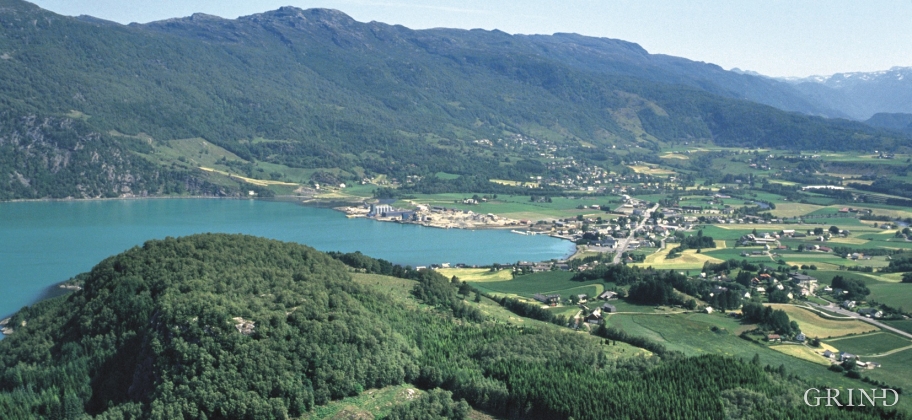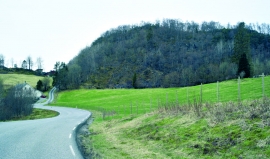Published: 08.01.2013 | Author: Svein Indrelid, Bjørn Myhre
The defensive refuge at Borgåsen with Etne Fjord and Etne Lake in the background. (Helge Sunde).
In Etne there are no less than four defensive refuges. They are all situated in strategic positions, so that they have served as places of refuge and protection for central parts of the district
Borgåsen, on the south side of Etnepollen (an arm of the fjord), takes its name from the fortified refuge from the Dark Ages, of which there are still traces. On the top there is a flat area, with steep slopes on three sides. On the fourth side a great wall has been put up, and remains of this are to be found within the area of fortification. One gets a full view over the sailing entrance to the Etne district from Borgåsen.
On the north side of Etnepollen, on the Bryllum farm lies Holenuten. You can only get up on to the top from the northeast. And up there are walls and barriers. In a little cave here charcoal and iron slag has been found.
Heia in Steine is an elevated height with an extended surface on the top and steep slopes on three sides. A great stone rampart, 36 metres long and 6 metres wide runs right across the surface and cuts off the 40 metres by 20 metre wide fortified area.
Hushaug is the name of a hill with steep slopes just above the Vad farm. On the only accessible side lies an 80 metre long wall which cuts off an area of 80 metres by 50 metres. From the fort at Vad there is a broad view out over the main district and up Stordalen valley. And here three old road routes come together: the road from Støle, the road from Grindheim and the road up through Stordalen valley. Vad gets its name from an old ford across the Stordal River.
Fortified refuges
In the Roman period and the period of the great migrations (from the birth of Christ to 600 AD) defensive forts were built on hilltops and on mountain crags, which were naturally difficult to get at. Where access to the fort was easiest, great walls of stone and ramparts of earth and sand were put up. In addition there were probably also wooden palisades.
Fortified refuges of this type have not been investigated much by archaeologists. Therefore we do not know a great deal about how these defensive installations looked during the time they were in use, and nor can we say much with any certainty about how their defence was organised, nor what function they had within the district or the region. Some were probably places of refuge for people who lived in the immediate vicinity, but there are indications that other forts can have been part of an organised defence of a larger chiefdom or small kingdom.
In Hordaland we know of 19 fortified refuges. Of these a total of 12 are situated in one small area in Sunnhordland. In Nordhordland there are 3, and there are 4 in Hardanger.
The forts in Sunnhordland are sited so that there are clear sightlines between each of them. Many of them are situated centrally within districts which have been densely settled during the Roman times and the period of the great migrations. We know of rich grave finds with imported Roman status goods from the same districts. Chieftains who could organise the defence of a small kingdom in Sunnhordland probably lived here. From the fort at Steinlandsåta in Ølen there is thus a wide view out over the whole of central Sunnhordland. From here you can see forts in Etne, Kvinnherad and Sveio.
In certain fortified refuges traces of house sites, wells and water hollows where the water could be collected have been found. In such forts people could hold out for weeks in times of instability.




